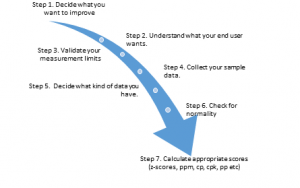We opened last week with Process Capability and before we go full-fledged into that area, I want to pause and put some focus on capability studies.
What is a Capability Study?
To review from last week, a capability study is a way to ensure that your process is consistent over an extended period of time. For example if step 3 in your process produces 3 errors per cycle for 3 years, your process in consistent.
How Do You Find Stability?
There are a ton of tools you can use to test the stability of your process, but some of the most common tools are Time Series Plots and Control Charts. In addition to these tools there is a step by step process (of course!) to test the capability of your process, here they are.
What should know about capability studies?
As with all 6Sigma tools, the effectiveness of this tools lies more in how you understand and how you apply it. The most important things to remember are:
- Capability studies are used to measure the same parts of the process, at the same stage in the process at exactly the same time every time it is measured.
- You can use the capability study on discrete and continuous data.
- You get the best (ie most meaningful) information when you run the study on already stable and predictable data. New processes are not the best place for this tool.
- When you hear Sigma Level, they are talking about capability.
- Capability studies require you to understand:
- The limits of your customer or organization.
- The difference between short-term and long-term
data and what those differences mean to your organization or customer. - Mean and standard deviation.
- How to assess normality of your data.
- How your organization or customer determine Sigma level.
Capability Studies can give you a great deal of insight on how your organization is running and what is making it difficult. This is one way to get a sense of the information flow and the quality of the information you can get your hands on. So let’s start off the new year with a look at what your data is telling you. Happy Hunting!


